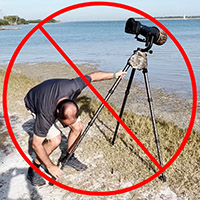Video: Essential tripod tips for wildlife photography
posted Monday, March 14, 2022 at 12:45 PM EDT

Getting the most out of your tripod for wildlife photography isn't as straightforward as it seems. Wildlife photographer Steve Perry sees many photographers making critical mistakes with camera support that ultimately costs them good photos. In a new video, Perry discusses the common mistakes and offers practical tips for taking full advantage of your tripod and returning home with sharp, beautiful wildlife images.
Let's start with your tripod setup. In many situations, it's a good idea to start by extending the largest leg sections first. The less you use the thinner sections at the bottom, the more stable your tripod. However, there's an important exception to this 'rule.' When you need to make rapid height changes, you want to work in reverse, extending the bottom leg sections first. This allows you to retain access to additional height near the top of your tripod. The sections you can still adjust are easily reachable. If you have a robust tripod, such as the Really Right Stuff TVC 34L MK2 tripod Perry uses – it's the newer version of the tripod I use and reviewed – the lower sections are plenty stable. The less you need to move while adjusting your tripod, the less likely it is that you scare a wildlife subject away, too.
When you're doing wildlife photography, it's likely that at some point, you'll put your tripod into mud, sand or water. This shouldn't hurt your tripod, but it's important to ensure that you don't stick the leg lock mechanism into mud or sand. It's okay to get the leg locks wet, but be sure to clean saltwater, sand and mud off as soon as possible.
Taller tripods are a worthwhile investment for numerous reasons. Long tripod legs help when setting up on uneven terrain for all sorts of photography. Concerning wildlife photography, it's not unusual to need to tilt your camera up toward a bird or other animal in a tree. In these cases, having your camera setup above you means you can shoot up without squatting. If you can afford a strong, tall tripod, your legs will thank you.
For more rapid-fire tripod tips, be sure to watch Perry's full video above. He discusses additional tips for tripod leg position, quickly leveling your tripod on uneven terrain, ensuring optimal stability and more.
To see more from Steve Perry, visit his website and check out his YouTube channel. It's full of excellent educational videos, including a recent video about setting up the Sony A1 for wildlife photography. For even more wildlife photography tips, don't forget to read our '9 Top Camera Tips & Techniques for Improving your Bird & Wildlife Photography' guide.
(Via Steve Perry)